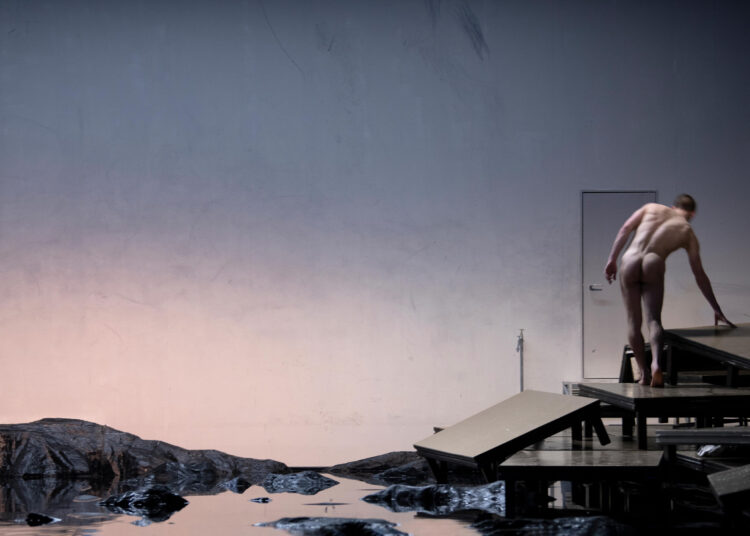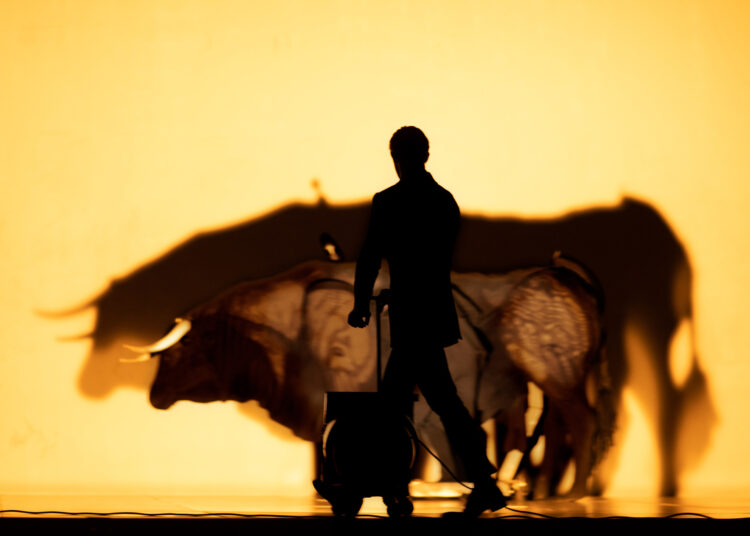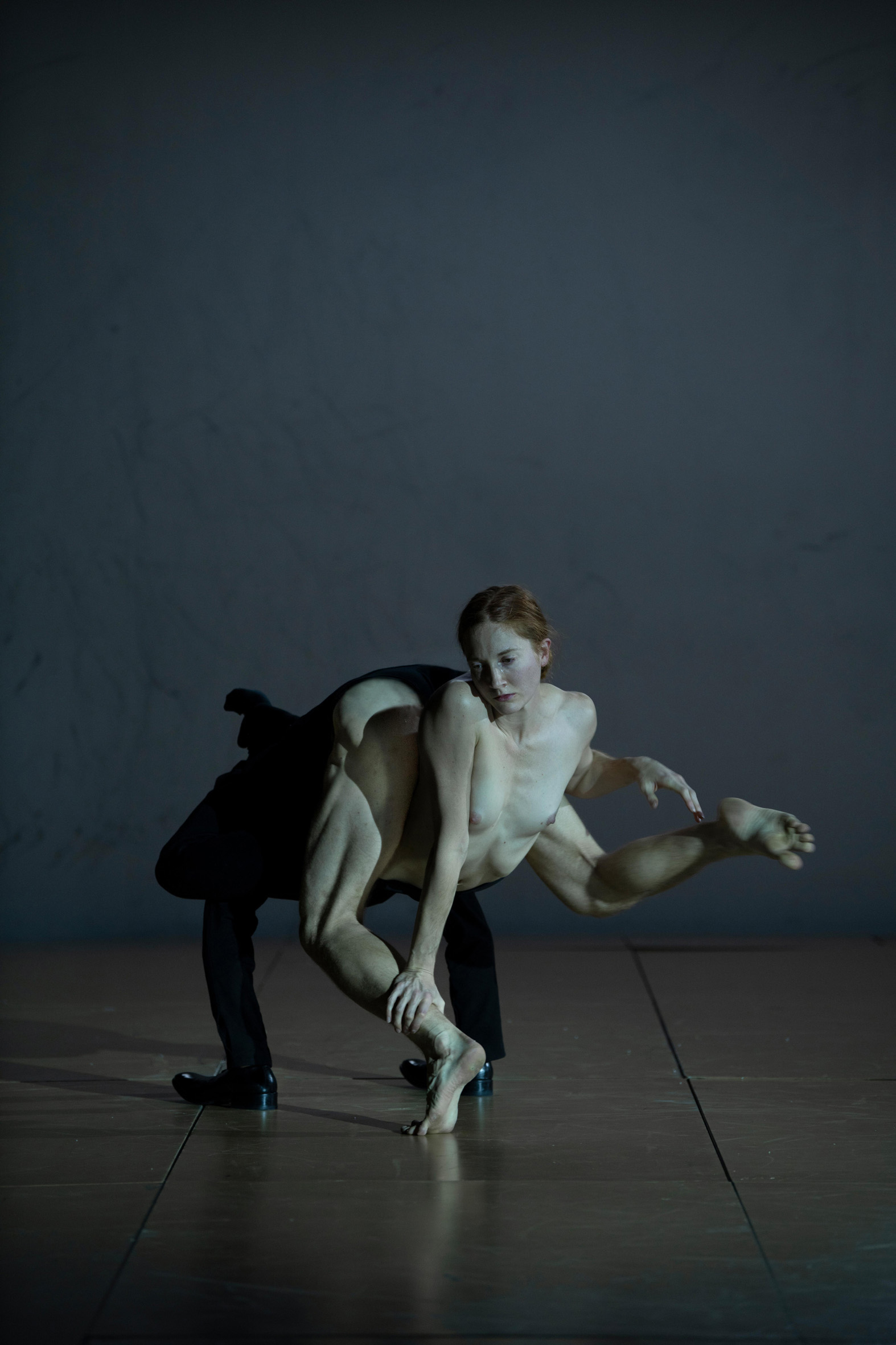Americans, and particularly New Yorkers, know and love the Third Millennium works of Dimitris Papaioannou, now a world-famous regisseur/choreographer of physical/total theatre. The Greek artist’s show Transverse Orientation is on at the Brooklyn Academy of Music/BAM’s New Wave Festival (7 -11 November) and, afterwards, at Stanford University, California (9-10 December). Since setting off from Lyon (France) in July 2021, the show’s long tour has had more than 100 performances and now comes to an end in the USA.
The pièce proceeds at a calm pace which induces contemplation, although there are moments of frantic fighting too; basically, we are on the Greek island of Ananfi, – where the Covid-19 pandemic and closing-down of theatres caused Papaioannou to spend the summer of 2020 – and this is especially clear if we pay attention to the admirable and perfect way the reflected lights change on the backdrop, which goes from white to crimson, then grey, orange, blue and pinkish-red, like a gentle, nostalgic sunset, with an interplay of cuts and rounds and a final reverberation of calm sea waves, which move the lights themselves, turning them into pure design – such refinement should be weighed up in its own right.

Dimitris Papaioannou. Photo: ©Julian Mommert
In Transverse Orientation, Dimitris has created a genuine choreography of lights which is also self-sufficient: it entrances and envelops us like a double track into which he gradually inserts his eight protagonists who have been hand-picked around the world, and Vivaldi’s music. The latter is also meticulously dosed, with each piece lasting no more than three minutes; the selected excerpts are from the Cello Concerto in D major (RV 407 Largo), the Concerto for“double choir” in B flat major (RV 583 Andante) and, almost as the finale, the Bassoon Concerto in G Minor, masterfully performed by L’Aura Soave ensemble from Cremona.
When the pièce begins we see seven extremely tall characters with tiny heads and elongated (thanks to hidden prostheses) arms: for these faceless creatures, hidden inside male burkas the only aim seems to be that climbing a skinny ladder in order to reach a neon light, located out of reach, which now and again makes a series of sharp, crackling noises. They cannot fail to remind us that one of Papaioannou’s early creative loves was for cartoons.
The entrance of a gigantic bull, to which all the male performers cling as if they are trying to tame it, can indeed be traced back to mythology, but certainly not to the myth of Theseus. The bull is broken-in quite quickly: a naked man climbs onto it and cries out triumphantly, overpowering the Vivaldi music. After a while also a naked magnificent girl dancer (Breanna O’Mara) positions herself on top of her colleague and then gets up and, still naked, walks around holding his penis. Many scenes smack of pop: all the men, in line, dance a few steps of a jolly Vivaldi tap dance, and then charge towards the backdrop in an attempt to climb up it like spiders. Not to mention the fuss over a metal chair which is similar to a folding bed/deckchair: after many an attempt to unfold it, even the lovely damsel ends up trapped inside the contraption, as if in an iron barrel.
 We also are trapped inside many unexpected moments, the most significant being the apparition of the alluring, naked girl astride the bull. Here the citation is (maybe) of the myth of Europa although the girl’s face is peaceful and serene without any sign of tension for having been raped. The human/divine/animal relationship is innocent. Even when the bull defecates and sullies the face of young Šuka Horn who has calmed it down – afterwards, as if to confirm it has been appeased, the bull licks him with its gigantic tongue. Moreover, one can smell the sea air. The woman riding the bull has a sea-urchin in the place of her vagina: it is cut in two and given to the naked young man who puts it in his bucket, into which he also then plonks his head. The sea, virtually present behind the backdrop at this stage in the performance, is presumably in turmoil: from the only door on the stage the men rush to save boulders of polyester, as if they were pieces of houses, as well as those everyday items that we’ve seen in so many tornado scenes on TV. Thank goodness that this stormy scene was preceded by another of those cartoon-style sketches: a naked man, initially a scuba diver with fins, reaches centre stage and leaps up and down gleefully – his feet close together like those of a penguin – while gold sparkle shimmers down all over his head and his impressive ‘number’.
We also are trapped inside many unexpected moments, the most significant being the apparition of the alluring, naked girl astride the bull. Here the citation is (maybe) of the myth of Europa although the girl’s face is peaceful and serene without any sign of tension for having been raped. The human/divine/animal relationship is innocent. Even when the bull defecates and sullies the face of young Šuka Horn who has calmed it down – afterwards, as if to confirm it has been appeased, the bull licks him with its gigantic tongue. Moreover, one can smell the sea air. The woman riding the bull has a sea-urchin in the place of her vagina: it is cut in two and given to the naked young man who puts it in his bucket, into which he also then plonks his head. The sea, virtually present behind the backdrop at this stage in the performance, is presumably in turmoil: from the only door on the stage the men rush to save boulders of polyester, as if they were pieces of houses, as well as those everyday items that we’ve seen in so many tornado scenes on TV. Thank goodness that this stormy scene was preceded by another of those cartoon-style sketches: a naked man, initially a scuba diver with fins, reaches centre stage and leaps up and down gleefully – his feet close together like those of a penguin – while gold sparkle shimmers down all over his head and his impressive ‘number’.
If, thanks to his Body Mechanical System,we’ve become accustomed to admiring Dimitris’ body-interlocking manoeuvres, then we won’t be disappointed. Here the woman interlocks with one of the other performers, but also the contrary takes place. Further on, the men squeeze in-between planks ending up against the backdrop. There are other citations which are disproved by a novelty: the delectable female figure turns into a fountain that appears out of nowhere and from which lots of water spurts. Is she a wet version of Botticelli ‘s Venus? Why not? The important thing is to notice that after having appeared in her triumph, she disappears underground. That is to say, underwater. It goes without saying that there follow other short struggles with the bull, pulled by ropes until, suddenly, it gets disassembled into a thousand segments:was it not, after all, an oversize toy? As we proceed towards the finale, everything calms down again, a contemplative calm with a woman enclosed in a real, ornate shell carried onstage without the slightest warning.
A large quantity of liquid, similar to milk, drips from her body, which is not completely covered in white, and in fact her womb gives birth to a baby. She strokes this round-headed baby and is taken away in her shell. The playing of Vivaldi has stopped and an old, fat, naked woman enters to the sound of silence, with a walking stick that noisily accompanies her steps. She dips her stick in the milk that is still there where the maternal shell was initially, and leaves. Does she represent death, in contrast with the life-giving we have just seen? Who knows? Certainly the neon light wobbles as she departs and a bell rings. What is going on?
 The door opens yet again and the gorgeous female dancer re-enters wearing pale violet, and pours more water out of a bucket. There are special light effects and this water muse (Thetis?) disappears once again underground. Just as well, because there is still a lot going on underwater. Six well-dressed men scramble, shaking and raising the floorboards, thus saving themselves from the impact of the water which is invading that part of the stage. But this time the sea has almost become calm; we admire the reflections of the waves as part of the visual choreography described earlier. And we see the young naked Šuka sitting completely still on one of the raised floorboards: he is looking out at the sea, we suppose, while a man vigorously starts to clean the wet floor with a mop.
The door opens yet again and the gorgeous female dancer re-enters wearing pale violet, and pours more water out of a bucket. There are special light effects and this water muse (Thetis?) disappears once again underground. Just as well, because there is still a lot going on underwater. Six well-dressed men scramble, shaking and raising the floorboards, thus saving themselves from the impact of the water which is invading that part of the stage. But this time the sea has almost become calm; we admire the reflections of the waves as part of the visual choreography described earlier. And we see the young naked Šuka sitting completely still on one of the raised floorboards: he is looking out at the sea, we suppose, while a man vigorously starts to clean the wet floor with a mop.
Conclusion: in Transverse Orientation, in addition to what we have already pointed out especially about the lights and music and the intrinsic minimalism of the set, we are faced with the pure and simple creation of landscapes. The mind-body is the protagonist of dreams and electromagnetic obsessions: we know how fascinated Papaioannou is by the research work of Serbian physicist Nikola Tesla. In an unsettling collage of fragments from his past as a creator, and free of any overt mythological intentions, Transverse Orientation takes on the form of memory, happiness and nostalgia for the driving force of the sea, which is the source of both destruction and salvation.












